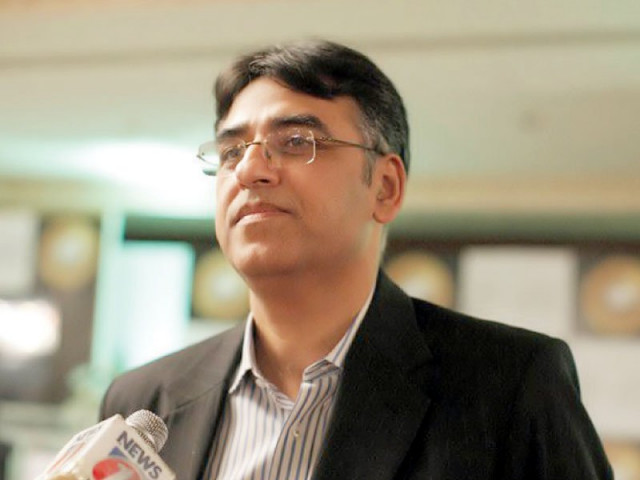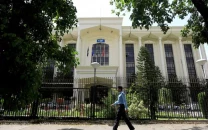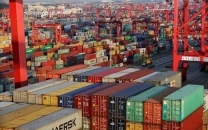PM opted for IMF deal despite another option: Umar
Umar said it was at PM’s discretion to decide whether to opt for the IMF programme or for the solution he had proposed

PTI leader Asad Umer. PHOTO: FILE
"In March [this year], I went to the prime minister and showed him the numbers. I told him that going to the IMF was now a choice as opposed to a compulsion," the Pakistan Tehreek-e-Insaf (PTI) leader, who is now the chairman of the National Assembly’s Standing Committee on Finance, said at an event organised by the Karachi School of Business and Leadership (KSBL).
Pakistan to further increase power tariff in Aug: IMF
“That choice had been created primarily because of the phenomenal goodwill of the prime minister in the global market, particularly in Asia, and a very mutually reinforcing relationship between the civil and the military arms of the government,” Umar told the audience.
Under the alternative plan, Umar wanted to put these factors to work and also use the Pakistani military’s good relations with Gulf countries to raise funds from the global capital markets and commercial banks and apply a combination of tariff and non-tariff barriers and gradual currency depreciation, according to an official familiar with these discussions at that time.
Umar said it was at the prime minister’s discretion to decide whether to opt for the IMF programme or for the solution he had proposed.
"Because every single expert agreed that we must go to the IMF, he decided not to take that risk,” he added.
The former minister quoted prime minister as telling him back then: “You know I am a risk-taker but everyone is saying that we should go to the IMF.”
The meeting in March had taken place exactly a month after Umar had told the prime minister about the adverse implications of the IMF deal.
In February, The Express Tribune had reported about Umar sharing some of the harsh conditions of the IMF package with the prime minister and Economic Advisory Council (EAC) members.
To support his argument at that time, Umar had cited the example of Egypt, where the poverty level had increased from nearly 30% to 53% because of an IMF programme.
Pakistan will get $38 billion to meet financing needs: IMF
Egypt steeply devalued its currency but that did not even help in reducing the current account deficit.
The government has added a cost of Rs4.323 trillion to the economy -- $27 billion -- since July last year because of the increase in the interest rate and currency devaluation, said Dr Ashfaq Hasan Khan, a member of the EAC and staunch opponent of the IMF programme.
“The currency devaluation added Rs3.21 trillion to external public debt and liabilities while the cost of the increase in interest rate stands at Rs1.11 trillion,” he added.
While quoting these figures, Dr Khan did even not calculate the additional cost that the consumers are paying after electricity and gas tariffs were increased twice to meet the IMF's conditions.
Umar acknowledged the role of former directors general of Inter-Services Intelligence (ISI), Naveed Mukhtar and Asim Munir, and then the army chief in convincing the Gulf countries to financially assist Pakistan.
“In a country where one of the biggest challenges you face is the weakness of the institutions, it would be short-sightedness if you don't try to use the strongest institution of the country to your full advantage,” said Umar.
"We worked as a team and got a $3.3 billion oil facility and $3 billion in cash injection from Saudi Arabia, $2 billion from the UAE, Chinese currency equivalent to $3 billion and $3 billion from Qatar.”
Umar said his ministry was able to squeeze the current account deficit considerably and also raked in money to bridge the gap and that was how the opportunity was created.
“The liquidity for emerging markets risks was phenomenal in the middle of this year. Tonnes of money were available for countries like Pakistan and we could have raised money through Eurobonds and Sukuk at that time,” he maintained.
"The money from commercial banks and capital markets was available to Pakistan but the price was relatively higher in the absence of the IMF programme," Umar told The Express Tribune on Friday.
“The army has particularly good relations with the UAE, Saudi Arabia and Qatar and that helped us in raising money from these countries.”
The official familiar with the alternative plan said it envisaged project financing from multilateral lenders, but programme financing was excluded from these projections.
The plan also involved drastic reduction in the current account deficit on the back of regulatory duties, non-tariff barriers and currency depreciation. But the currency deprecation was less than what Pakistan went for under the IMF deal.



















COMMENTS
Comments are moderated and generally will be posted if they are on-topic and not abusive.
For more information, please see our Comments FAQ